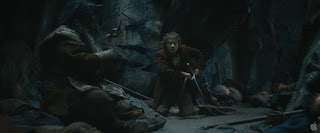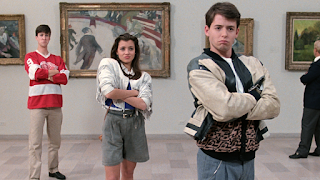This is a blog post in order for me to express and suggest some possible visuals for the cave aspect of the film which makes up bout 80% of the film, as a result this will be the predominant style and it is important for me to really nail the look that I want and establish a solid visual theme. As a result my first port of call was to look at some films that also feature caves and look at their visuals and the mood this creates.
The first place I looked was to a personal favourite film of mine, the hobbit: an unexpected journey. This film features two different and very contrasting cave scenes, the first image is a behind the scenes shot of the riddles in the dark scene which sees Gollum playing a game of riddles with Bilbo. This is predominantly a tense scene that features heavily on suspense and being trapped, this is done through close in shots mostly in the scene and the addition of the huge lake that hems in Bilbo and renders him trapped as it acts as an invisible almost psychological barrier that keeps him there. This isn’t strictly like the film I would like to make as it is more suspenseful and a little bit more action based than I would like my film to be, however, there are aspects I can mimic, for example I now see how effective manipulating the empty space in a shot can be to making people feel trapped, although there will have to be a healthy blend of close shots for trapped and wide emptiness for isolation, this will be a struggle to get the correct blend but it is certainly possible. The second scene is closer to what I want to achieve in that it features multiple characters, although most are little more than background in this scene. Though it does feature heavily on character and conversation. As a result it is somewhat brighter so we can properly see the people involved, but it also stays dark and gloomy to keep that feel intact. The colour in this scene plays a big role, it’s mostly dark shades of dull couloirs, which adds to the darkness but also the overwhelming feeling of them being in a bad situation with little hope.
This shot is taken from the ogre story thread from Tale of Tales. This cave is probably a little off what I want to achieve due to its clearly open nature and the fact that it is much too bright for her to be physically trapped in there. However she is still trapped, by the ogre granted not a physical wall like in my film, but the shot choice still reflects this, if we look at the one I chose, what space is available is between the two of them, showing they’re not close, metaphorically, and every border of the shot is dominated by the walls, this again boxes them and particularly her in, it really makes her look isolated and alone even when she’s with someone, couple this with the fact that even though this is a wide shot not a close up as in the Hobbit, she still seems trapped, this is something I will definitely look to replicate.
The final film I looked at was Samctum, granted this is not the best option for comparison to my film and I mainly looked at it to explore another possible angle, however, there is one key thing that has come to mind and been made a must for me in my film and that’s practical light. Seeing this made me realise that just by adding a second light into my scene from say a torch or lantern or fire, then all of a sudden I have opened a whole host of doors to experiment and manipulate lighting. I’m adding a practical light I no longer have to think of why would there face be lit this way if their only light is a small opening, this is because with a practical light I have a justifiable extra light source to act as a key light or fill light, whereas before I would have had to limit my lighting options based purely upon how natural light behaves.
That’s all for now this has been just an outline and summary of some potential lighting styles and visual themes I have seen and will potentially mimic.



















